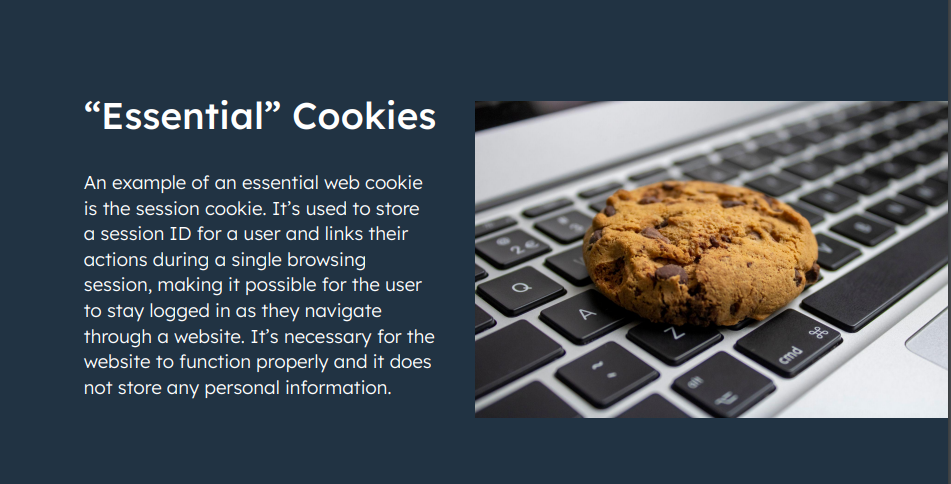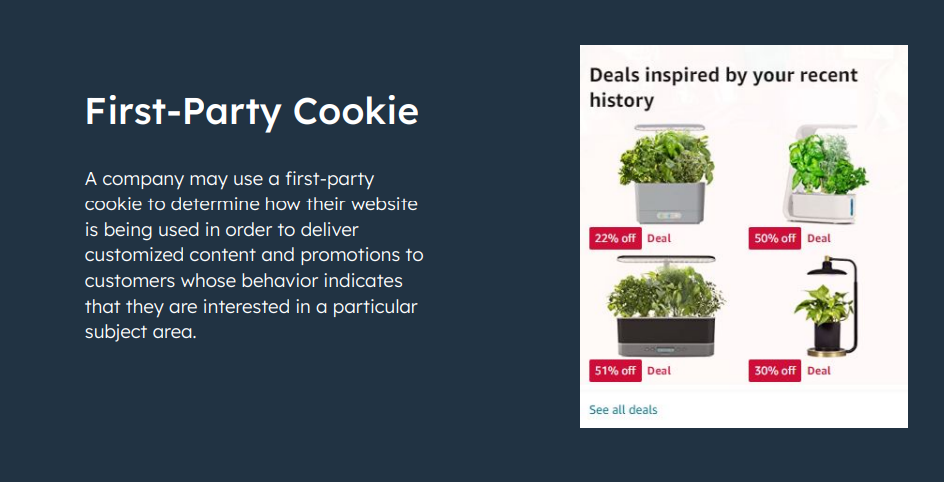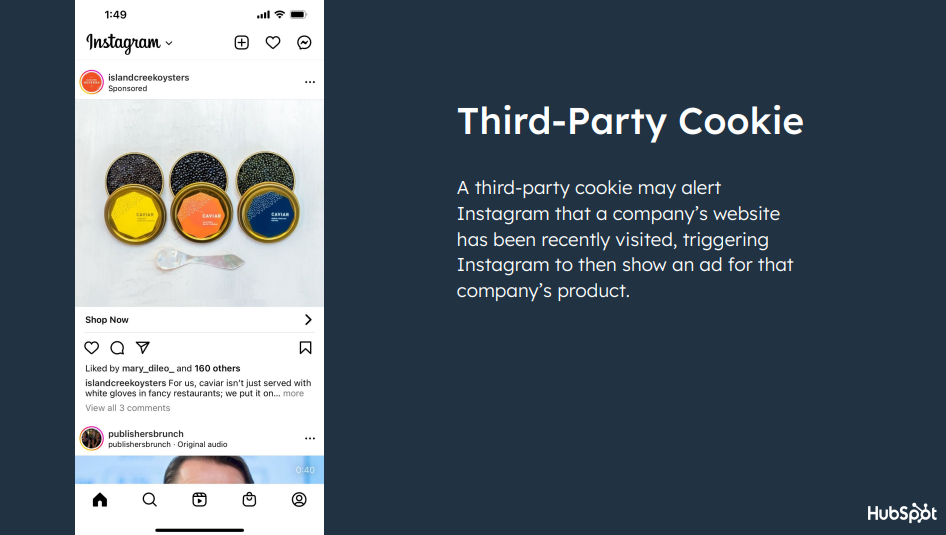If you’re a marketer who includes digital advertising in their content mix, you’ve probably been reliant on third-party cookies to help drive campaign success. And for good reason —the type of data you can gather about your audience with this form of cookie is significant, including consumer interests, habits, and browsing patterns, giving you insight that you can leverage to help make smarter decisions. But moving forward, marketers will need to shift their strategy to be less reliant on this type of data.
Understanding Cookies and Third-Party Tracking
But before we cover why, let’s back up a bit. What exactly is a cookie? And what is meant by “third-party” in reference to cookies?
Acookie is a small file containing a string of characters that’s sent to your computer when you visit a website allowing that website to recognize your browser when you visit it again. Cookies set by the website owner are called “first-party cookies.” First-party cookies collect data directly from your audience, whether customers, site visitors, or social media followers.
Cookies set by parties other than the website owner are called “third-party cookies.” Third-party cookies are tracking codes placed on a web visitor’s computer after being generated by another website other than your own. When a web visitor visits your site and others, the third-party cookie tracks this information and sends it to the third-party who created the cookie — which might be an advertiser.

So why do sites use cookies? First-party and third-party cookies are used for several reasons. Some cookies, referred to as “essential” or “strictly necessary” cookies, are required in order for websites to operate. One example of an essential web cookie is the session cookie. It’s used to store a session ID for a user and links their actions during a single browsing session, making it possible for the user to stay logged in as they navigate through a website. This type of cookie is necessary for the website to function properly and it doesn’t store any personal information. Other cookies enable companies to track and target the interests of their users to enhance their website experience.
Here’s Molly Mitchell, product marketing manager at LinkedIn, to share more.
Molly Mitchell:
First party cookies are those that are owned and used by the website that a person is visiting, and their purpose is to benefit the user experience with the brand’s website. For example, they may remember information like a username, or what items have been added to a shopping cart. Unlike third-party cookies, first-party cookies are not deemed non-essential, and are often painted as a better, more privately friendly alternative. Third party cookies are a piece of code that can be placed on a user’s device from an ad tech company or domain which is di erent from the site that a user may be on third-party. Cookies have existed largely to support digital advertising and have been deemed non-essential. Third-party cookies have become a major focal point for online privacy, and many browsers have already made moves to block them by default, or have announced plans to do so in the future.

For example, a company may use a first-party cookie to determine how their website is being used in order to deliver customized content and promotions to customers whose behavior indicates that they’re interested in a particular subject area. The same company may use third-party cookies for advertising, analytics, and other purposes. For example, a third-party cookie may alert Facebook that a company’s website has been recently visited, triggering Facebook to then show an ad for that company’s product.

If you’ve ever wondered how a social media site knew how to serve up exactly what you were searching for, a third-party cookie was likely involved.
For the last two decades, third-party cookies have enabled businesses to secure rich data on their customers, partners, and prospects. But that’s no longer the case.
So, what’s changed?
Over the past few years, consumers have become increasingly concerned with how companies use their data and many feel passionate about protecting their privacy. In fact, Nexorank Blog research found that 80% of consumers believe data privacy is a human right.
Because of this increase in concern, Firefox and Safari browsers have been blocking third-party cookies by default for the last few years. In 2021, Apple even introduced its App Tracking Transparency , which gave iOS users the option to stop ads from tracking their online activity. And Google has stated that by the end of 2024 , Chrome will eliminate the use of third-party cookies as well.
Let’s hear from Matthew Felser, head of global advertising partnerships, business engineering at Meta to learn more.
Matthew Felser:
The digital advertising ecosystem is evolving. Users are increasingly protective of their privacy on the Internet, and governments around the world passed data regulations to put people in more control of how their data is being used. Additionally, many browsers and operating systems are making technical changes to phase out the usage of third-party cookies. These regulations and technical changes ultimately limit the viability of third-party cookies as a tool for advertisers. To provide better transparency control, companies must give people visibility into how their data is being used and the ability to state their preferences regarding that data usage. They must use technologies that reflect people’s privacy, choices, and they must leverage data in compliant ways. These restrictions may break the connection between data platforms currently in use across the industry which will require businesses to think di erently about how they source and use data for advertising.
So, what happens if third-party ads go away? Ad-tech vendors have done a great job putting a bit of fear into the hearts of marketers and advertisers who have relied on third-party cookie technology to retarget ads to users after website visits. But is it really all that bad?
Let’s look at it this way:
Have you ever had the experience of buying an item and then afterward seeing tons of ads for that same item in all your Instagram, Tiktok, and Pinterest feeds, not to mention on every website you visit? This happens when companies use retargeting, a tactic that relies on the use of third-party cookies. Retargeting works great when a user is browsing for something because they see it more often. It takes advantage of a specific type of bias we have as humans, the Baader-Meinhof Phenomenon , otherwise known as a frequency illusion or recency bias, a situation where something you recently learned about suddenly seems to appear everywhere. And of course, the more you see the item, the more popular it seems, and the more you might consider buying it.
But retargeting isn’t so great when it results in over-targeting, giving consumers the sense that they’re being tracked and stalked wherever they’re browsing. Over-targeting can be
even more annoying if third-party ads are shown to someone who might have randomly browsed an item without intent to purchase. It can lead to lowered brand trust, and many consumers end up installing ad-blockers to eliminate ads entirely.
Molly Mitchell:
It’s not bad that the industry is moving away from third party cookies. Consumer trust is critical to ensuring a healthy digital ad ecosystem, so it’s not bad in that sense. These changes provide immense opportunity for the ad industry to come together to develop new standards and solutions that facilitate a healthy ad ecosystem for advertisers with consumer privacy at the forefront.
Eliminating third-party ads has other benefits to businesses as well. A few years back, JP Morgan Chase analyzed their ads and determined that advertising broadly across 400,000 sites had the same e ectiveness as advertising on only 5,000 pre-approved sites. This determined that many of the sites didn’t have real people using them in a natural way. By focusing on sites with real publishers and actual human audiences, they had better outcomes and were able to dramatically cut costs.
But what does this mean for marketers?
For the most part, these changes are a huge win for consumers and their personal privacy. But it’s a massive blow to marketers who had traditionally relied upon these tracking methods to map a potential customer’s buying journey and serve up relevant ads across the various web and social media platforms the customer might traverse.
That means marketers need to come up with new ways to understand and connect with their potential customers. Additionally, with the heightened focus on privacy, data security has become a critical component for long-term customer retention and loyalty, so it’s vital that brands behave responsibly when it comes to collecting and protecting consumer data.
The good news is that marketers have a variety of old and new tactics that they can tap into. Information about website and social media audiences will still be available as first-party or second-party cookie data. There are also new opportunities for brands to connect through the use of artificial intelligence, machine learning, contextual advertising, and conversational marketing.
In the future, marketers and advertisers will need to rely on cookieless tactics to target and reach their audiences. Fortunately, this new, cookie-free world can ultimately result in better user experiences for consumers. And that may lead to heightened customer loyalty, stronger word-of-mouth, and a better bottom line for your business.



















